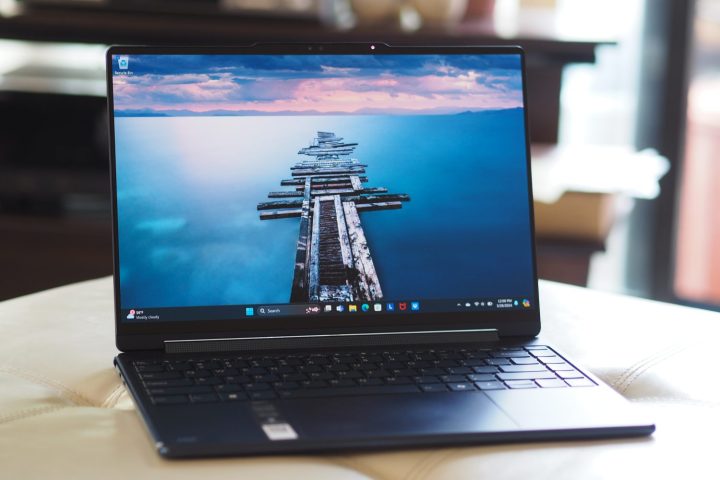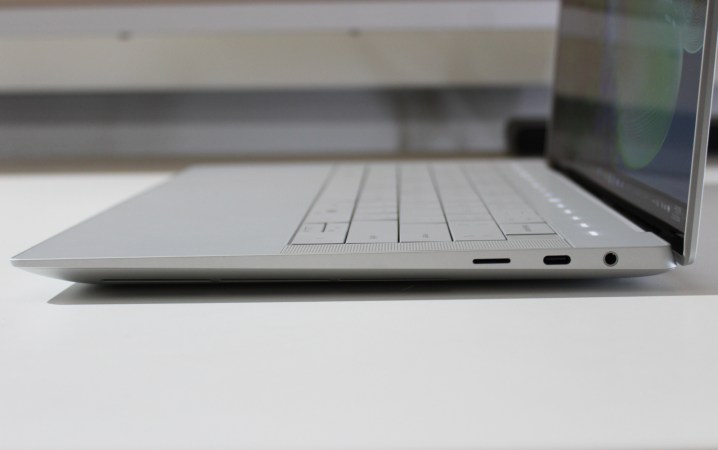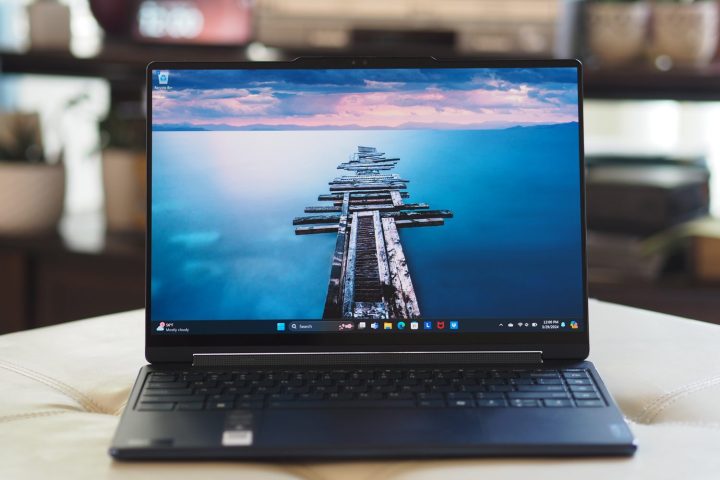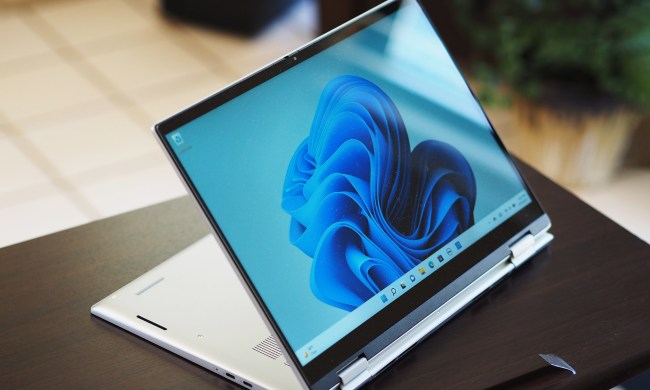
The 14-inch laptop has become increasingly popular thanks to its slightly larger screen size and yet still portable chassis. Unsurprisingly, there have been in influx of great 14-inch laptops as manufacturers try to leapfrog each other in performance and value.
The Dell XPS 14 and Lenovo Yoga 9i Gen 9 are two such laptops. While they’re different in form factors and configuration options, they both are great machines. But which one is right for you?
Specs and configurations
| Dell XPS 14 | Lenovo Yoga 9i Gen 9 | |
| Dimensions | 12.6 inches x 8.5 inches x 0.71 inches | 12.40 inches x 8.58 inches x 0.6-0.64 inches |
| Weight | 3.8 pounds | 2.98 pounds |
| Processor | Intel Core Ultra 7 155H | Intel Core Ultra 7 155H |
| Graphics | Intel Arc Nvidia GeForce RTX 4050 |
Intel Arc graphics |
| RAM | 16GB 32GB 64GB |
16GB 32GB |
| Display | 14.5-inch FHD+ (1920 x 1200) IPS non-touch, 120Hz 14.5-inch 3.2K (3200 x 2000) OLED touch, 120Hz |
14.0-inch 16:10 2.8K (2880 x 1800) OLED touch, 120Hz 14.0-inch 16:10 4K+ (3840 x 2400) OLED touch, 60Hz |
| Storage | 512GB PCIe Gen4 SSD 1TB PCIe Gen4 SSD 2TB PCIe Gen4 SSD 4TB PCIe Gen4 SSD |
512GB SSD 1TB SSD |
| Touch | Optional | Optional |
| Ports | 3 x USB-C with Thunderbolt 4 1 x 3.5mm audio jack 1 x microSD card reader |
2 x USB-C with Thunderbolt 4 1 x USB-C 4 1 x USB-A 3.2 Gen 2 1 x 3.5mm audio jack |
| Wireless | Wi-Fi 6E and Bluetooth 5.3 | Wi-Fi 6E and Bluetooth 5.1 |
| Webcam | 1080p with infrared camera for Windows Hello | 5MP 2.5K with infrared camera for Windows 11 Hello |
| Operating system | Windows 11 | Windows 11 |
| Battery | 69.5 watt-hours | 75 watt-hours |
| Price | $1,699+ | $1,329+ |
| Rating | 3.5 out of 5 stars | 4 out of 5 stars |
Lenovo’s pricing and configurations are always subject to change, but as of when this comparison is being written, the base Yoga 9i Gen 9 costs $1,329 with a Core Ultra 7 155H, 16GB of RAM, a 512GB SSD, an a 14.0-inch 2.8K OLED display. The only higher-end configuration currently available ups the storage to 1TB and opts for a 4K+ OLED display. All models come with integrated Intel Arc graphics.
The XPS 14 comes in more configurations, starting at $1,699 for a Core Ultra 7 155H, 16GB of RAM, a 512GB SSD, Intel Arc, and a 14.5-inch FHD+ IPS display. Upgrading to 64GB of RAM, a 4TB SSD, an Nvidia GeForce RTX 4050 GPU, and a 14.5-inch 3.2K OLED panel costs $3,699.
So, the XPS 14 starts at a higher price and becomes very expensive, very quickly.
Design

While they’re both 14-inch laptops, the XPS 14 and Yoga 9i Gen 9 are very different machines. The XPS 14 is a traditional clamshell while the Yoga 9i Gen 9 is a 360-degree convertible 2-in-1, and though the XPS 14 has a larger display, it’s almost the same size in width and depth thanks to insanely thin display bezels. But it’s also a lot heavier and thicker.
With the Yoga 9i Gen 9, you not only have a more portable laptop but also one that offers more flexibility with the ability to morph from a clamshell into media, tent, and tablet modes. It also supports an active pen for drawing and writing on the display. Both laptops are solidly built with all-aluminum chassis.
Aesthetically, these are both gorgeous laptops. The XPS 14 has a more angular chassis with a conservative design on the outside. Open it up and it’s thoroughly modern with a hidden haptic touchpad beneath an all-glass palm rest, a zero-lattice keyboard, and a row of LED touch function keys. The Yoga 9i Gen 9 has smooth, rounded edges and a more traditional island keyboard and mechanical touchpad.
The Dell can be had in either Platinum or Graphite colors while the Lenovo is available in Cosmic Blue and Luna Grey. Both are great-looking laptops, but you won’t be choosing on looks alone.

Both laptops have good keyboards, with snappy, precise switches. The XPS 14’s keyboard takes more getting used to with the minimal key spacing, but beyond an initial learning curve, it’s as good as the Yoga 9i Gen 9’s version. The XPS 14’s haptic touchpad also has a learning curve but offers the ability to click anywhere compared to the mechanical touchpad on the Yoga 9i Gen 9. Both of the Lenovo 2-in-1’s display options support touch and a pen, while just the higher-end OLED display option supports touch (only) with the XPS 14.
While both machines have the same number of USB-C ports, the XPS 14 has one more Thunderbolt 4 port while the Yoga 9i Gen 9 also offers a USB-A port for legacy support. The XPS 14 has a microSD card reader, which the Yoga lacks, and both support the same Wi-Fi level that’s just one step behind the bleeding-edge Wi-Fi 7.
Lenovo built a higher-resolution 5MP webcam into a reverse notch that also offers an easy way to open the lid, and both offer infrared cameras for Windows 11 Hello facial recognition. The XPS 14 also has a fingerprint reader built into the power button for those who prefer that method of logging in. Each laptop has user-presence-sensing technology that can log the laptop off and put it to sleep when the user walks away and then wake it up and log back in when the user returns.
Thanks to the Intel Meteor Lake chipset in each, there’s a Neural Processing Unit (NPU) for on-device AI, which today is mostly limited to some processing done by Microsoft’s Studio Effects videoconferencing software.
Performance

Both laptops are built around the same 28-watt Intel 14th-gen Core Ultra 7 155H chipset with 16 cores (six Performance, eight Efficient, and two Low Power Efficient) and 22 threads. It’s a popular chipset that promises fast productivity performance and can also do well in creative apps and gaming when paired with a discrete GPU.
The Yoga 9i Gen 9 only has integrated Intel Arc graphics, which falls somewhere between the older Intel Iris Xe graphics and the entry-level Nvidia GeForce RTX 4050 GPU. The XPS 14 can be configured with the RTX 4050, which makes it a potentially faster laptop.
We tested the XPS 14 with the slightly faster Core Ultra 7 165H, but even when equipped with the Core Ultra 7 155H, it would provide slightly faster performance in CPU-intensive tasks than the Yoga 9i Gen 9 thanks to better thermals. And in the Pugetbench Premiere Pro that runs in a live version of Adobe’s Premiere Pro video editing application and can utilize the GPU, it provides a clear advantage.
Both laptops are fast enough for even demanding productivity users, but the XPS 14 will be faster for creators and gamers.
| Geekbench 6 (single/multi) |
Handbrake (seconds) |
Cinebench R24 (single/multi/GPU) |
Pugetbench Premiere Pro |
|
| Dell XPS 14 (Core Ultra 7 155H / RTX 4050) |
Bal: 2,334 / 13,070 Perf: 2,344 / 12,818 |
Bal: 84 Perf: 72 |
Bal: 101 / 681 / 5,738 Perf: 100 / 772 / 5,811 |
Bal: 3,274 Perf: 3,547 |
| Lenovo Yoga 9i Gen 9 (Core Ultra 7 155H / Intel Arc) |
Bal: 2,264 / 11,647 Perf: N/A |
Bal: 98 Perf: 81 |
Bal: 101 / 594 / N/A Perf: 102 / 670 / N/A |
Bal: 2,015 Perf: 2,329 |
Display and audio

The XPS 14 offers two display options, a 14.5-inch 16:10 FHD+ (1920 x 1200) IPS panel running at up to 120Hz and a 3.2K (3200 x 2000) OLED panel at up to 120Hz. The Yoga 9i Gen 9 can be equipped with a 14.0-inch 16:10 2.8K (2880 x 1800) OLED display running at 120Hz or a 4K+ (3840 x 2400) OLED display at 60Hz. Only the XPS 14’s IPS display is less than ideal in terms of sharpness at this size, while the Yoga’s 4K+ option is most likely overkill.
We tested the XPS 14 with its 3.2K OLED display and the Yoga 9i Gen 9 with its 2.8K OLED panel. The Yoga’s display was slightly brighter and had wider coverage of the AdobeRGB color gamut. Both displays have excellent color accuracy and deep contrast offering up inky blacks. They’re both great options for productivity, creative, and media consumptions usage.
| Dell XPS 14 (OLED) |
Lenovo Yoga 9i Gen 9 (OLED) |
|
| Brightness (nits) |
374 | 400 |
| AdobeRGB gamut | 85% | 97% |
| sRGB gamut | 100% | 100% |
| DCI-P3 gamut | 100% | 100% |
| Accuracy (DeltaE, lower is better) |
0.50 | 0.59 |
| Contrast ratio | 15930:1 | 27,790:1 |
The XPS 14 has a four-speaker setup with two side-firing woofers and two upward-firing tweeters flanking the keyboard. The Yoga 9i Gen 9 has a unique soundbar housing dual tweeters, and two woofers are fire to each side. In our testing, the Yoga provided louder and clearer sound with more bass, and is among the best sound systems in a 14-inch Windows laptop.
Portability

As mentioned earlier, the Yoga 9i Gen 9 is thinner and lighter than the XPS 14. It will be a bit easier to carry around.
In terms of battery life, the XPS 14 lasts considerably longer. It made it to 8.25 hours in our web browsing test compared to the Yoga’s roughly six hours, and around 10 hours in our video looping test compared to around 8.5 hours. The XPS 14 is therefore more likely to last closer to a full day’s work.
The XPS 14 is faster and longer lasting but more expensive
If you need the flexibility of a 2-in-1, then the Yoga 9i Gen 9 is your only choice here. And it’s considerably less expensive than the XPS 14.
But Dell’s clamshell is faster, especially when configured with its discrete GPU, and it gets much better battery life. If you have the money, then the XPS 14 is the better choice for most people.


